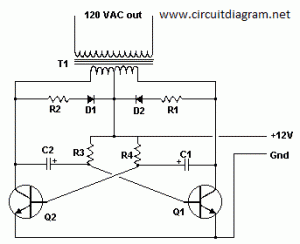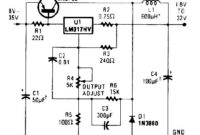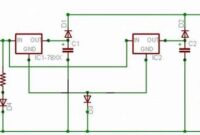The following diagram is the basic design diagram of inverter circuit. The circuit will convert 12V DC to 120V AC. This basic inverter circuit can handle up to 1000Watts supply depends the T1, T2 and transformer used. Please see the note.
Basic Inverter Components list:
| Part | Total Qty. | Description | Substitutions |
| C1, C2 | 2 | 68 uf, 25 V Tantalum Capacitor | |
| R1, R2 | 2 | 10 Ohm, 5 Watt Resistor | |
| R3, R4 | 2 | 180 Ohm, 1 Watt Resistor | |
| D1, D2 | 2 | HEP 154 Silicon Diode | |
| Q1, Q2 | 2 | 2N3055 NPN Transistor (see “Notes”) | |
| T1 | 1 | 24V, Center Tapped Transformer (see “Notes”) | |
| MISC | 1 | Wire, Case, Receptical (For Output) |
Notes:
1. Q1 and Q2, as well as T1, determine how much wattage the inverter can supply. With Q1,Q2=2N3055 and T1= 15 A, the inverter can supply about 300 watts. Larger transformers and more powerful transistors can be substituted for T1, Q1 and Q2 for more power.
2. The easiest and least expensive way to get a large T1 is to re-wind an old microwave transformer. These transformers are rated at about 1KW and are perfect. Go to a local TV repair shop and dig through the dumpster until you get the largest microwave you can find. The bigger the microwave the bigger transformer. Remove the transformer, being careful not to touch the large high voltage capacitor that might still be charged. If you want, you can test the transformer, but they are usually still good. Now, remove the old 2000 V secondary, being careful not to damage the primary. Leave the primary in tact. Now, wind on 12 turns of wire, twist a loop (center tap), and wind on 12 more turns. The guage of the wire will depend on how much current you plan to have the transformer supply. Enamel covered magnet wire works great for this. Now secure the windings with tape. Thats all there is to it. Remember to use high current transistors for Q1 and Q2. The 2N3055’s in the parts list can only handle 15 amps each.
3. Remember, when operating at high wattages, this circuit draws huge amounts of current. Don’t let your battery go dead :-).
4. Since this basic inverter project produces 120 VAC, you must include a fuse and build the project in a case.
5. You must use tantalum capacitors for C1 and C2. Regular electrolytics will overheat and explode. And yes, 68uF is the correct value. There are no substitutions.
6. This circuit can be tricky to get going. Differences in transformers, transistors, parts substitutions or anything else not on this page may cause it to not function.





Hey this info is sufficient but wanted more discription about circuit flow.
Sir, i’m impressed with your website and i really appreciate your ciruit diagrams but please can i get a software for electronics practicals
In fact you are too much, please can all these components;Silicon diode,resistors, Tantalum Capacitor
2N3055 NPN Transistor locally purchased in Nigeria? If yes where can easily get it.
Thank You sir.
where can i insert load detector circuit?
sir i am a student of the university of benin with mat no, psc0704525 (for confirmation & to eliminate doubts) edo state, nigeria. there are so many thing i love to ask but i really want to how i can have acess to the invert component as well as solar panel. send me a reply soonest.
i need circuit diagram for 1kva pwm inverter
if u have send me on my id djkdipti@gmail.com
sir could you please explain the operation of the circuit?
the only thing is the transformer will break the bank those things get REALLY expensive when u get to the high power ones
sir iwant ordinary battery charge cut off circuits.any inverter
SIR I NEED 12V TO 120V DC TO AC INVERTER CIRCUIT, THE ABOVE CIRCUIT COMPONENTS IF NOT FOUND THEN BY SUBSTITUTIONS WHAT I USE,
could you please send me a 12v dc 240ac inverter circuit diagram,
honestly i will be greatfull.
Thanks.
how long will this project works?….tnx!!!
good day sir, I was really thankful for giving me the opportunity to have this incredible mosfet power amplifier. although i still not assembled the amps. i know that its really quite good. thank you and more power to you and god bless you.
Dear sir
I want to make 12v dc to 240v ac,500 watts inverter.plz send the message which requirements i need and send me circuits and parts name in my mail address.
Sir,
can i use other transformer?
yummmy:P thx for your tips i’d love to follow you.anyway happy new year ~~~~~~~~
i really appreciate people like you at least for bringing out your time to to post these circuit
and their diagrams.it’s been quite helpful.thanks a lot but i want to know:how can i decide to step
up the power(i.e the wattage)if i so desire and what is the current rating of this particular
circuit.thanks
Hi sir, thanksfor your site I realy like it cos it helps me a lot but the only problem I have is the inverter is not working well for me and I need more help from you.Thanks very much for your good work.
Dear sir,
I am really highly impressed going through your website. It has often be my heart desire to try my hands on DC-AC inverter, going through your website has revived that I-can-do-it altitude in me. I would be very grateful if you could assist me with other necessary information/materials to fulfill my dreams. Also I will like you to throw more light on the effect of connecting induction load to DC/AC inverter.
i am intrest to design circuit